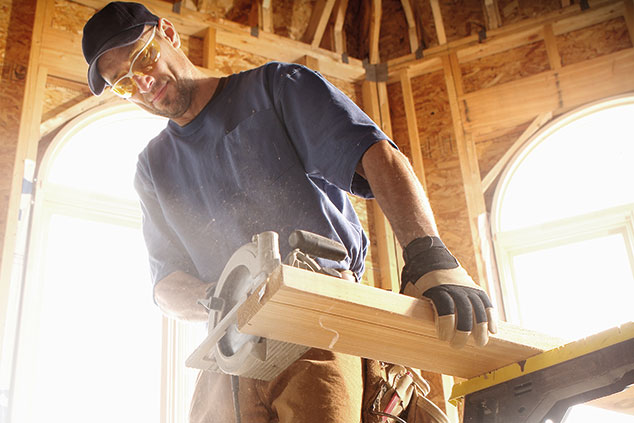
Whether it’s frustration with the high price of poor-quality identikit rabbit hutches, or simply the desire to have a unique home, many of us have dreamed of building our own properties. But while it can be both satisfying and profitable (self-build mortgage broker BuildStore reckons the average self-built house is worth about 25% more than it costs to construct, dependent on location), it’s not a decision to take lightly – it requires plenty of planning, resilience and finance.
The practicalities
First, figure out your budget, your likely costs and location. When doing your sums, factor in a contingency of at least 10% for overspends. Once you’ve identified an area you’d like to build in, speak to the local planning department to get an idea of the types of developments and applications they would support, consider, or point-blank refuse – it will save you a lot of time.
Finding a suitable plot can be a long and arduous process, but there are database providers to make the search easier (PlotSearch, PlotFinder and PlotBrowser). You can also contact local councils, estate agents, farmers, landowners and generally network. Auctions are another option.
And get to know your neighbours. Obtaining planning permission can take a lot of time and they are the ones who are most likely to make or break your plans. So discuss any issues they might have in advance. Use a local architect if possible – they will know the local planning team and understand which features are favoured and discouraged, which should boost your odds of approval.
Paying for it all
Unless you’re able to fund the project from savings, you’ll have to borrow the money. There are various funding options, depending on your plans for the property. If you want to live in it yourself, you’ll be eligible for a self-build mortgage, assuming that you plan to live there for at least three years. Rates are currently around
4%-6% a year, for a two-year loan. This is significantly higher than a conventional loan due to the perceived risk to the lender.
Self-build mortgages differ from normal mortgages in that you plan in stages and draw down the money at specific milestones. In other respects they are very similar to a normal mortgage, and are based on the ability of the borrower to repay. Most lenders will require at least outline planning permission to start the application process, and detailed planning permission before the mortgage is released.
There are two types of self-build mortgage: the arrears type, where payments are given as each stage of the build is reached; and the advance type, where payments are released at the start of each stage. The latter is better for cash-flow purposes, enabling you to draw down funds as needed to pay for labour and materials.
As a general rule, you may be able to borrow up to 75% of your project costs, with lending multiples of 4.5 to five times income, based on costs and outgoings. That said, BuildStore offers a range of cost-based advance-stage mortgages that allow you to get your build underway with as little as 5% for a deposit. With a cost-based mortgage your payments are guaranteed on your project costs, irrespective of any property valuation carried out by the lender.
Some small building societies also specialise in this niche. Ones worth contacting include Saffron Building Society and Ecology Building Society.
What if you plan to let it out?
If you are planning to let the property out instead, then you’ll need a short-term development loan secured against the project, or a bridging loan against an existing property. Development loans aren’t income based, although a lender will check affordability. Rates differ widely across the market, influenced by the experience of the developer; the loan amount; the site location; and the ratio of the loan to gross development value; but are typically from 5%-9% a year.
Alternatively, if your existing house is unencumbered and has sufficient equity in it, you could raise 100% of your build costs with a bridging loan. This lets you buy your plot and carry out the building works, after which the loan and any outstanding mortgage can be repaid. Bridging rates typically start at 0.44% a month, based on a loan-to-value of 55%.
The build itself
A good builder can project manage and bring in all the trades. While this will add 10% to your costs, it should avoid any nasty surprises. If you’re not paying for a project manager you need to be available on site to make quick decisions and ensure everything is going to plan. If you’re building from scratch you’ll also need to connect to services (gas, mains water, electricity) and this should be factored in as it can cost tens of thousands of pounds.
Get a structural engineer’s advice early on in the build as this can save you money. The relationship with building control should also be nurtured, as your local building control office is there to help rather than catch you out, and can share a lot of valuable knowledge.
Save tax by building your own house
There is no stamp duty to pay on building costs or the value of your house once the work is done. You only have to pay duty on the cost of the plot itself if the cost is above £125,000.
Self-builders can also claim back most of the VAT paid out on the build.
The arrangements for reclaiming are set out in VAT notice 431NB, “Refunds for DIY housebuilders”. You can also apply for exemption from the community infrastructure levy.
Lastly, don’t forget to get a structural warranty to insure your build for defects for ten years from completion. Most lenders will insist you get one from a recognised source, such as the Local Authority Building Control.